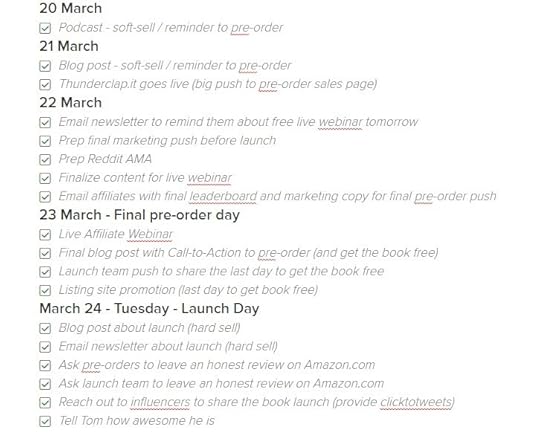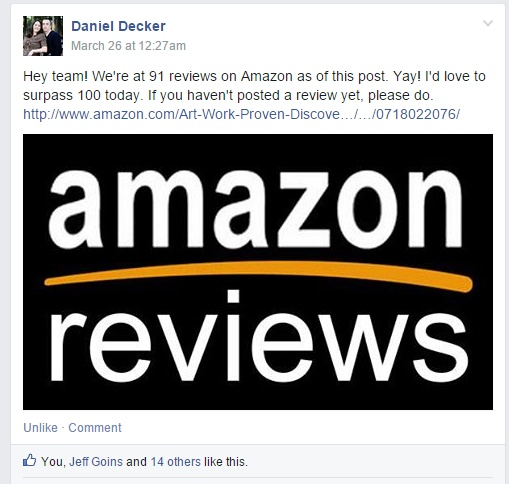The Good, the Bad, & the Ugly of Launching a Best-selling Book
Recently, I shared with you the lessons I learned from launching my first best-selling book, The Art of Work. Now, I want to tell you how I did it. (If you don’t want to read all 3500 words of this post, just skip to the summary.)

Photo Credit: KJGarbutt via Compfight cc
A quick word of warning: Every book, and every launch, is different. In this post, I did my best to pull the principles out of the details, but don’t try to do exactly what I did — it won’t work.
Instead, learn from my mistakes and do something better. Book publishing is an ever-changing industry, so what worked yesterday won’t necessarily work tomorrow.
Now without further ado, here’s how my team and I launched a best-selling book. My book launch co-conspirator, Tom Morkes, helped me compile this post so he deserves the credit for tracking and organizing all this information.
The plan
The first thing you want to do is create a strategy. Before you bring your book to market, you need clarity on a few key elements that will play a significant role in your launch:
1. Goal: What do I want to accomplish?
For The Art of Work, I wanted to sell 10,000 trade paperbacks before launch (these are called preorders). The stretch goal was to hit a best sellers list. And though I would have liked to set a less concrete goal like “change people’s lives,” there would have been no way to measure that.
Why did I choose the number 10,000? Two reasons:
With the size of my audience, 10,000 people seemed doable (though challenging).
10,000 people is a lot of people. It’s enough, in my opinion, to make some waves in the world (which was my bigger why behind what I was doing — I wanted to change the way people think about their vocations).
When setting goals, you want to make them precise, measurable, and time sensitive.
2. Timeline: How much time do I have?
In December, I met with my publisher, Thomas Nelson, and decided on a strategy we believed would get us to 10,000 pre-orders by the end of March.
To develop a proper book marketing timeline, you need to:
Back plan from the launch date.
Set measurable objectives along the way. In this case, we identified how many total pre-orders per week we would need on average, when we would launch the book site, and when we would start emailing my list to initiate the campaign.
Fill in the timeline with key marketing and promotional objectives (e.g. send an email to my list, guest post on blog X on topic Y, reach out to influencer Z, etc.).
The timeline is a living document that will change and evolve as you move through the launch sequence and something that ought to be influenced by your entire team — or at least key people in charge of the marketing. Here’s a snapshot of what ours looked like:

3. Resources: What will it take to accomplish this?
Resources include whatever assets or means you can put behind your book launch. These should include:
Your blog
Your email list
Your social media channels
Your personal network (which can leverage into an active team)
This is just a snapshot of the resources that will directly influence the success or failure of your book launch. But the point is to use whatever you have and not wish for something unrealistic.
I would have loved to have been on Oprah or Good Morning America, but that wasn’t likely. So I used what I had: my blog, my email list, and my connections. You need to do the same: use whatever resources are available to you.
Building the team
After you create your plan, you’re going to want to compile your team, which will come from your list of friends, even family, and anyone who follows your work. Sometimes, these people will come out of the woodwork and surprise you.
For The Art of Work, Daniel Decker led the launch team via a private Facebook Group. We invited people via Twitter and Facebook to apply through an online form and accepted the first 250 applications.
The private group gave me the ability to interact directly with the people who would be the front line in our marketing and promotional activities — from writing reviews, to spreading the word.
If you’re going to do this, I recommend having someone (even a volunteer) help you manage the group. Because you will get busy and overwhelmed, and you don’t want to neglect these people. Daniel was a pro at this.

The beauty of a launch team is you don’t have to be pushy or promotional — these are people who want to help. Your job is to give them simple, actionable steps to do that.
Here are some ways to leverage a launch team:
Ask them to leave a review on Amazon, Barnes & Noble, and Goodreads when the book launches (assuming you’ve given them free access to the book early — which you should).
Encourage each member to write a review on their own blog. In exchange, highlight these people on your blog when the book launches! See below for how we did that.
Coordinate a Thunderclap.it campaign (a great way to get a lot of eyeballs on your book during launch day as long as the campaign succeeds — so make sure you set a low enough goal that you can achieve it).
Share important blog posts, guest posts, or listing site mentions and ask members to support by checking it out and sharing if it resonates. I told our team that I’d retweet as many of them as possible when they talked about the book.
There are dozens of other effective ways to turn a launch team into a remarkable marketing effort. Just make sure to make it valuable for your team.
For The Art of Work, this meant giving people the opportunity to interact with me on a personal level. We used this opportunity to answer questions, do live calls, and much more. Keep it fun, light, and engaging and your launch will do wonders for you.
Finding the right channels
How will you reach your target readership and early adopters?
This is the point where most launches fail. Even if you have the best book in the world it won’t matter if you can’t cost effectively reach your target audience.
Many authors make the mistake of depending on bookstores or their publishers to make their sales for them. And sure, these sources might generate some sales, but I promise you this: nobody will care more about your book’s success than you. So the secret weapon to a great book launch is you.
The secret weapon to a great book launch is you.Click To Tweet
Sales aren’t automatic. It takes finding and connecting with likeminded readers to move the needle. To do this, you need to identify effective marketing channels.
A marketing channel is any medium or platform you can use to promote and sell your book.
Here are the channels we used:
Blogs and podcasts. We reached out to niche blogs and podcasts to see if they wanted to interview me. The power in niche blogs and podcasts isn’t sales numbers, but the trust that gets built when an author and his book seem to be “everywhere.” This ties directly into what’s called the mere-exposure effect: the more we see something, the more we like it. By agreeing to hundreds of interviews, I was able to help The Art of Work reach a large audience of potential readers.
Listing sites. A listing site is a place where likeminded people come and share cool things (usually links to products, images, or ideas). Examples include: Reddit.com, Bootstrapper.io, and Produchunt.com, among others. Some of these listing sites can result in tens of thousands of eyeballs on your book if you position it right.
Reddit AMA. Reddit.com AMA’s (ask me anything) are increasingly popular events where interesting people agree to answer questions during a specified time period. The cool part about an AMA is that you can not only engage with the audience you’ve already built, but compelling AMAs drive lots of eyeballs to your event. I did one here and will admit that I probably don’t “get” Reddit. But at least I tried.




